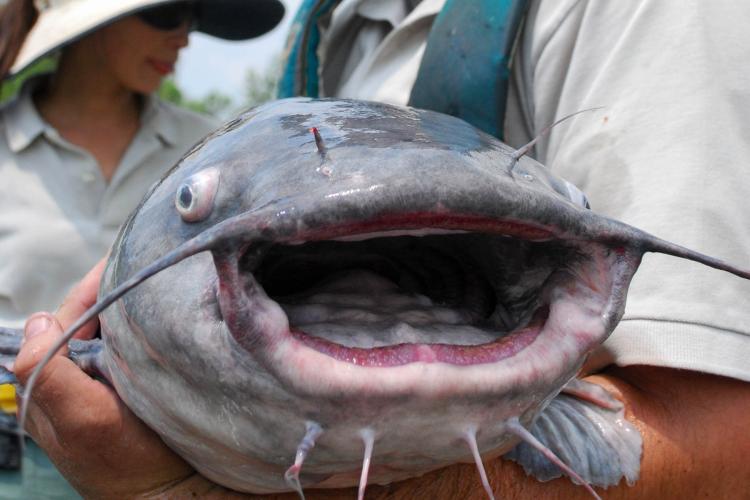Catfish Spawn Creating Angling Drama

By Dennis Doyle
Our newest Bay sport fish species, the blue, channel and flathead catfish, are definitely affecting the summer angling dynamic this year—namely by their spawn.
While they’ve been widely available since early spring, these species have now started their reproduction routines and seem to prefer the Chesapeake Bay tributaries rather than the main stem in waters above 75 degrees. They individually select dark, submerged structures among large boulders and similar debris for the protection of their roe masses from tidal and river currents. There, the males prepare spawning beds to attract the females. Unfortunately none of these species will feed during this phase so expect them to be a bit more difficult to catch for the next few weeks.
After depositing their yellow eggs in sticky masses, the females are then pushed off the beds by the males, who will fertilize the roe and guard the nesting sites (still fasting) for another six to 10 days until the eggs hatch. The hatchlings will remain nearby in a tight, compact group for up to two weeks, still guarded by the males, until they eventually disperse throughout the shallows to feed and grow, many to reach prodigious sizes.
Flatheads prefer the fresher waters of the tributaries for their spawn while blues and channels can tolerate just about anything saline in the Chesapeake, a detail that has totally surprised fisheries biologists who expected them to be contained in the fresher water areas. Virginia officials, who had continually stocked blue catfish in the James River beginning in the 1960s, estimated back in 2015 that the blue cat population in the Chesapeake had grown to about 100 million, according to an article in the Baltimore Sun (2019).
In years past, I have occasionally caught rockfish with stomach contents of young catfish, 2 to 4 inches long. I suspect that the frequency of this discovery will increase dramatically as our stripers learn to key in on the increasing numbers of catfish reproducing in the Bay and the tendency of the newly hatched fingerlings to remain in small, densely packed schools.
After spawning and protecting their offspring, all species of catfish will once again disperse throughout the tributaries and into the Bay main stem, feeding and moving to deeper waters for the rest of the summertime season. The largest catfish (both blues and flatheads can exceed 100 pounds, the channel cats up to 50) will prefer the darker, deeper waters, especially those depths involving boulders, tree stumps, construction remains and similar debris.
Now, and in the coming dog days, there is one period of time that is definitely better for catching the big, over 20-pound whiskerfish: nighttime.
Since all catfish have poor eyesight but acute scent detection—thanks to their barbels and their skin—they do a lot of food foraging in the wee hours. Though they’ll eat almost everything in the Bay—shellfish and crabs included—their favorite dish is generally a chunk of menhaden, mud shad, chicken breast, spot, white perch or even a night crawler. A bucket of frozen, ground menhaden in a chum net over the gunnel will definitely help them zero in on your baits.
Although all hook types are legal for catfish, rockfish may well be drawn to your baits when chumming, so it’s a wise move to always use circle hooks and in a larger size than normal. You never know just how big your next fish will be.
